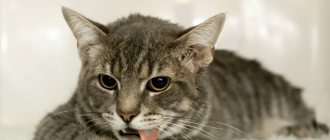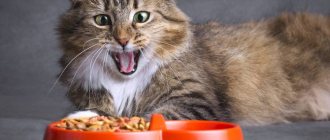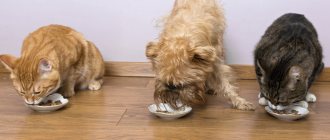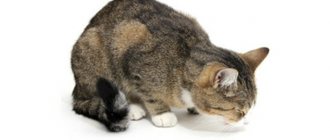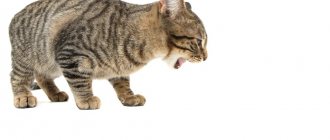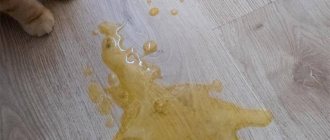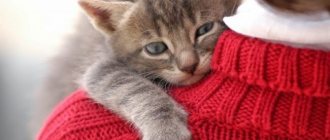Article from the portal: zen.yandex.ru/ivethelp
The reflex that provokes vomiting is a special mechanism launched by a center in the brain and is carried out by contracting the muscle fibers of the diaphragm and peritoneum. Sudden changes in pressure inside the peritoneum cause a sharp release of stomach contents through the oral or nasal cavity.
If a cat vomits yellow liquid, this may cause problems with the pancreas, stomach, gallbladder or its ducts, as well as problems with the hepatorenal system.
The yellow color of vomit occurs as a result of the penetration of bile. In a normal physiological state, bile should not be in the stomach, since it has a pronounced ability to irritate the walls of the stomach.
In addition to the bright yellow color, the vomit acquires a distinct, specific smell of bile. The appearance of a similar symptom in a cat requires immediate medical attention.
Yellow foam and vomiting - what does it mean?
The gag reflex is a special defense mechanism of the animal, which is a simultaneous contraction of the abdominal muscles and diaphragm. A sharp jump in intra-abdominal pressure provokes the release of gastric contents out through the oral cavity. The cat is vomiting yellow liquid. This may be due to disturbances in the functioning of the pancreas and stomach, pathologies of the gallbladder and its ducts, diseases of the liver and kidneys.
© shutterstock
Types of cat vomit:
- Vomiting foam . A gag reflex with yellow or white foamy liquid may be a sign of a serious illness such as feline distemper or panleukopenia. A distinctive feature of vomit is the absence of additional impurities (wool or food residues) in it. Without timely treatment, these diseases inevitably lead to the death of the pet.
- Cats vomit after eating . If a cat eats quickly and a lot, then its digestive system cannot cope with the volume of incoming food, and it spontaneously ejects from the animal’s mouth. The result is regurgitation of food, saliva, mucus, and white or yellow foam immediately after eating. Dry food can also be a factor that provokes vomiting with foam.
- Diet and vomiting . The cat vomits after a fatty meal - this condition can only be eliminated through a special diet. Nausea and yellow foam can occur in animals on a dry diet; it is important to correctly alternate between natural and store-bought food, and always provide your pet with water.
- Wool vomiting . Wool is a frequent guest in the digestive sections of a cat, as animals constantly lick themselves and swallow saliva. The accumulation of hairballs in the stomach causes obstruction and, as a result, a gag reflex with yellow foam and mucus. Blockage of the gastrointestinal tract may be accompanied by vomiting with foam, bile, blood and food debris. In this case, there is only one treatment - urgent surgery.
- Vomiting due to injury . Damages to the internal organs of an animal are always accompanied by a gag reflex interspersed with blood. If the gallbladder and liver are injured, yellow foam may be released, and if the lungs and bronchi are injured, white foam will be released. A characteristic feature of this situation is the absence of other symptoms associated with the functioning of the animal’s digestive system.
- Parasitic infestations and vomiting . In the first stages, helminth infection is accompanied by the release of white or yellow foam from the cat’s mouth; worms and larvae can also come out through the mouth. If a cat burps yellow liquid, this means that his body is full of helminths and is poisoned by their waste products.
- Vomiting due to disease of the internal organs . Yellow vomit with foam means that the pet has pathologies of the liver and gall bladder. At the same time, the smell of vomit contains the smell of bile. The cat may also have diarrhea with bile and blood.
- Infection and vomiting . Yellow vomit and watery diarrhea are the first signs of infectious diseases in cats. Among them are herpes, calicivirus, rhinotracheitis and others.
- Surgery and vomiting . Complications after surgery in cats may be indicated by yellow vomit with foam, bloody clots and saliva. The release of anesthesia can also occur accompanied by a gag reflex with foam.
- Intestinal obstruction and vomiting . This is a formidable and dangerous symptom, meaning that an obstacle has formed in the cat’s intestines to the natural release of digestive products. Intestinal blockage can be urgently eliminated only by surgical intervention in a clinical setting.
- Cat pregnancy . If a pregnant cat is vomiting yellow liquid, this may indicate that she has gallbladder and duct disease that has worsened due to pregnancy.
© shutterstock
Interesting! In the cat breed, the gag reflex, as an instinct of self-preservation, is much more developed than in other pets - dogs, birds, rodents, and so on. Therefore, cat breeders face this life problem quite often and must be well versed in this topic!
Symptoms
Vomiting in a cat that is yellow in color, even once, is a reason to contact a veterinarian, as it is a serious symptom indicating a disruption in the functioning of the body.
You should immediately go to the clinic if your pet experiences repeated vomiting with bile and bloody clots, concentrated with mucus. Such symptoms indicate intestinal volvulus, perforation of the stomach by an ulcerative lesion, or the disintegration of a malignant tumor in the area of the intestinal loops.
In case of fountain vomiting (when it is not possible to leave the house with the animal), it is necessary to call a doctor at home. The younger the animal, the higher the risk of dehydration during prolonged bouts of vomiting.
In addition to the fact that the cat is vomiting bile, other characteristic symptoms may be observed:
- breathing problems;
- profuse diarrhea;
- febrile conditions in the animal;
- coma in a cat;
- swelling in the peritoneum;
- sudden weight loss;
- the cat refuses to drink water and does not eat (symptoms indicate intestinal volvulus).
It is problematic to independently identify the cause of what is happening, and prescribing independent treatment is also dangerous for the animal’s life. Any delay in providing qualified assistance to a cat can cost it its life.
When contacting a veterinary hospital, the veterinarian conducts a general clinical examination and collects a detailed medical history. The medical history must indicate what the animal ate on the eve of vomiting and whether there are any chronic diseases.
In some cases, the doctor may only need a clinical examination and history taking. But in the vast majority of cases, serious examinations are required to make an accurate diagnosis. Accurate diagnosis includes:
- ultrasonography;
- radiography of liver structures, gallbladder and intestinal loops;
- computed tomography for suspected tumor processes;
- endoscopy to exclude inflammation in the stomach and duodenum;
- general blood and urine analysis;
- examination of vomit samples.
The cat has yellow vomit - reasons
In most cases, it is bile that turns a cat's vomit yellow. An admixture of bile appears as a bright yellow color and a specific odor; these signs are difficult to confuse with something else. The causes of cat vomiting lie in diseases of the liver and choleretic tract.
A similar gag reflex can occur after eating stale or low-quality food, as the load on the liver increases significantly.
Cats very often vomit from fatty foods, which is also associated with overload of internal organs - the liver and gall bladder. Antibiotics have a depressant effect on the liver and can cause a gag reflex with bile. An overdose of any medication can cause yellow vomit with foam or mucus.
What you should pay attention to when an animal is vomiting:
- circumstances and time of the first vomiting;
- frequency of urges, volume of vomit;
- consistency, composition and amount of vomit per day;
- does the cat still have an appetite?
- Is there any desire left to drink?
- the presence of other symptoms and their nature;
- duration of the gag reflex relative to the first vomiting;
- does your pet have chronic diseases?
- Has the cat been vaccinated and dewormed?
© shutterstock
Green and yellow vomit indicates that a large amount of bile has entered the stomach, and intestinal contents are also present. If your pet eats grass, the vomit will appear green. Yellow vomit with mucus indicates erosive changes in the mucous membranes of different parts of the animal’s digestive system.
Causes
The penetration of bile into the stomach is caused by antiperistaltic contractions of the duodenum. Vomiting of a liquid consistency with a yellow color occurs for the following reasons:
- Panleukopenia (feline distemper). The most dangerous viral disease.
- Worm infestation.
- Changing food to energy-rich food. The cat vomits the contents of undigested lumps of food. Over time, bile gets mixed in. Consultation with a fellinologist or veterinarian helps you choose a gentle diet and solve the problem.
- Swallowing an inedible object. If a foreign body gets stuck in the stomach, bile secretion reflexively increases.
- Chronic hepatitis.
- Intestinal pathologies.
- Inflammation of the gallbladder. Causes of the disease:
- Blockage of the canal with a stone or tumor.
- Bacterial infections.
- Trematodes, Giardia.
- Traumatic rupture of the bladder.
- Complications after surgery.
Vomiting foam and bile - possible diseases
The cat vomited yellow liquid! Repeated yellow vomiting with impurities of food and foam indicates the presence of an inflammatory process in some part of the animal’s digestive system. The stomach cannot cope with the volume of food entering it, spasms begin with the release of vomit. To make a correct diagnosis, it is better to contact a veterinary clinic, because there are a lot of diseases associated with the digestive system - gastritis, pancreatitis, ulcers, duodenitis, colitis and so on.
Attention! The cat is vomiting white foam, the provoking factor in this case is hunger. After all, white foam is the result of a chemical interaction between protective mucus from the walls of a hungry stomach and oxygen from the surrounding air.
Yellow vomit with foam and blood may occur due to internal bleeding in the animal's intestines, stomach, or esophagus. If there is a tumor or ulcerative formation, bloody streaks will be present in the vomit along with foam. If the shade is scarlet and uniform, this means that blood is secreted in the upper gastrointestinal tract - the pet’s mouth, larynx or esophagus. Bleeding is dangerous and does not go away on its own - you definitely need emergency help from a specialist veterinarian!
What to do if your cat vomits after eating? How to stop a cat from vomiting?
If you don’t have the opportunity to see a specialist, try to alleviate your pet’s suffering. First of all, remove the food. Even a small piece of food can cause your pet to vomit. Unsolder the animal. Then the diet should be gentle and consist of easily digestible foods.
If you suspect that your pet has been poisoned, the animal needs to urgently give Enterosgel to the cat if it is vomiting . The drug used to treat cats acts in the same way as in the human body. Once in the cat's gastrointestinal tract, the drug absorbs endogenous and exogenous toxins of various natures, poisons, radionuclides, heavy metal salts, bacteria and bacterial toxins. Twelve hours after administration, the drug will remove toxins from the body naturally.
It has proven itself well and quite often the drug phosphalugel is prescribed to cats when they are vomiting. “Phosphalugel” is effective for any intestinal or gastric disorders caused by intoxication or chemicals entering the cat’s body. It envelops the walls of the stomach, preventing the absorption of irritating and toxic substances into the mucous membranes. In addition, the drug adsorbs harmful compounds. The product does not cause alkalization of gastric juice, maintaining the acidity of the animal’s gastric contents at a physiological level. If a cat is vomiting, the dosage of the drug “phosphalugel” will depend, first of all, on the weight of the animal and the nature of the disease.
You can avoid cases of vomiting of undigested food in a cat, as well as any other types of vomiting, if you properly monitor your pet and take the necessary preventive measures. These include:
- Proper cat nutrition. And this is high-quality ready-made food for the animal or balanced natural food. If you feed your animal bad or expired food, you will not be able to avoid watching the cat vomit from dry food . If a cat eats food from the table, it may develop problems with the liver, kidneys, stomach and intestines.
- Annual cat vaccination against infectious diseases.
- Carry out antiparasitic therapy twice a year.
- Brush the animal regularly. Periodically give your cat special food or paste to remove hair.
- Be very careful! Make sure that the animal does not have access to indoor plants, trash cans, threads and needles, New Year's tinsel, garden and household chemicals. Buy only high-quality toys that do not contain toxic materials. Watch their condition. They must be strong and solid.
- Once a year, be sure to give your pet a preventive examination at a veterinary clinic. If you have a kitten under one year old or an animal over 10 years old, a preventive examination must be done at least once every six months.
Diagnostic measures
In a veterinary clinic, if a yellow liquid is vomiting, the doctor will carefully examine the cat, palpate its stomach, check its mucous membranes and measure its body temperature. Next, he will need detailed information about the cat’s condition, as well as documents with notes on vaccination, deworming and previous diseases.
To make a correct diagnosis, the following manipulations are usually performed:
- X-ray of the intestines, liver, bladder;
- CT scan;
- Ultrasound of internal organs;
- endoscopy;
- biochemical and general blood test;
- analysis of stool, vomit and urine.
Owners should not refuse diagnostic measures, because they are all aimed at saving the cat’s life. Unfortunately, even modern diagnostic methods do not always make it possible to find out the causes of vomiting yellow liquid, so they often complement each other. For example, ultrasound and x-rays will not help determine poisoning, and also do not always show acute inflammatory processes in the gallbladder and liver. This is why doctors prescribe additional tests.
What does each discharge indicate when vomiting occurs?
If your pet has vomited a couple of times at most and is feeling quite normal, there is no need to panic. This can be caused by intestinal irritation, which occurs due to swallowing fur or a large clump of grass. In this case, it is recommended to monitor the pet’s condition for one day and then look for the reasons for the deterioration of its health.
The cat may vomit bile, as indicated by the yellow color, and may also suffer from other discharges. Regular vomiting of a rich yellow or green hue primarily indicates that there are problems in the functioning of the liver or kidneys. There may also be stomach problems.
Blood present in the vomit may indicate that the esophagus or pharynx has been damaged by some sharp object, such as a fish bone.
When you need to see a doctor urgently
Sometimes a cat develops symptoms that signal that the animal requires immediate professional help:
- Frequent vomiting that lasts more than 5–10 hours. If your cat has vomited more than once and is constantly thirsty, she most likely has kidney problems.
- Temperature increase.
- Weakness and apathy.
- Very unpleasant smell of vomit and the same smell from the mouth.
- Diarrhea.
- Convulsions or fainting.
- Presence of blood or mucus in the vomit.
- Refusal of water and food. If your cat is vomiting but refuses to eat and loses weight, you may have lipidosis. With this pathology, too much fat accumulates in the liver area. As a result, the functioning of most organs is disrupted, and toxins accumulate in the body itself. A cat showing signs of lipidosis must be hospitalized as soon as possible, otherwise it will die.
- Fountain vomiting.
- Darkening of urine.
- Yellowness of the mucous membranes.
- Problems with passing urine. Sometimes, when vomiting and increased thirst, cats practically do not go to the toilet. This most often occurs when the animal's urinary tract is blocked by stones or worms. In such a situation, urgent surgical intervention will save the cat from death.
Why does my cat vomit yellow liquid?
Vomiting in a cat is a protective mechanism whose task is to cleanse the body of foreign substances. Pet owners cannot always determine the root cause of yellow vomit on their own. Therefore, in most cases it is advisable to contact a specialized specialist.
Malnutrition or, conversely, overeating can disrupt the digestive process of an animal. For example, if a cat falls asleep hungry, its stomach is empty all night - in this case, there is a high probability of morning vomiting. A full stomach can occur due to the consumption of large amounts of food. Then the food simply will not enter the intestines and will travel in the other direction. In addition, food poisoning is a common cause of vomiting.
In some cases, vomiting is accompanied by severe discomfort in the animal. This may be caused by ingestion of a foreign object. If it is small, it will come out in the feces. But with large dimensions of the object, active production of bile acids in the stomach will begin. Vomiting of yellow foam often occurs after excessively sudden changes in diet, with a sharp increase in caloric content of food. The cat's liver may not respond immediately to other feeding conditions. As a result, undigested food and yellow liquid will be observed in the vomit.
Vomiting with bile can also be caused by the presence of helminths. This is how the body tries to get rid of the presence of worms. Yellow vomiting is not uncommon in chronic diseases of the liver, gallbladder, and intestines. The negative impact of infectious pathological diseases and the penetration of foreign viruses or bacteria also affects. As a result, the animal’s liver will actively cleanse the body of toxic substances. The most common and dangerous cause of vomiting is considered to be feline distemper or panleukopenia.
Yellow foamy liquid signals the development of various ailments. However, it is important to take into account additional symptoms that accompany vomiting. With hepatitis, the cat's body temperature rises, appetite decreases, urine darkens, diarrhea and yellowness of the mucous membranes occur. If vomiting yellow liquid has a sharp, unpleasant odor, this may indicate liver failure. Moreover, this is how not only the acute, but also the chronic form of the disease manifests itself. An unpleasant odor from the mouth, frequent fainting, yellowing of the sclera, nausea are signs of the development of serious pathological processes in the liver.
Vomiting yellow foam is a symptom of lipidosis, which is also accompanied by rapid exhaustion of the animal, accumulation of toxic substances directly in the liver, and complete loss of appetite. With feline distemper, the temperature rises sharply to high levels, and the pet becomes apathetic. He is haunted by frequent vomiting, diarrhea accompanied by a pungent odor, and the disease is also indicated by a hunched posture, lack of thirst and appetite.
Of course, it is unacceptable to ignore such manifestations. Only timely medical intervention will help avoid many unpleasant complications.
What does the appearance of vomiting and blood in the stool indicate?
Bloody feces are quite common in cats. Common causes include constipation if your pet eats too much dry food. Prolonged defecation leads to constipation, and hence blood in the stool. In this case, it is worth reviewing the diet, and the pet’s stool will return to normal.
If your cat has yellow vomiting and bloody feces for a long time, you should be wary, as this may indicate a dangerous disease.
This is often how a disease called hematochezia manifests itself. It is accompanied by heavy bleeding in the lower intestine. Many people confuse it with melena, but with this pathology the stool is black. Hematochezia is accompanied by apathy of the pet; he refuses food and water, and also often runs to the toilet. If you have these signs, you should immediately contact your veterinarian.


